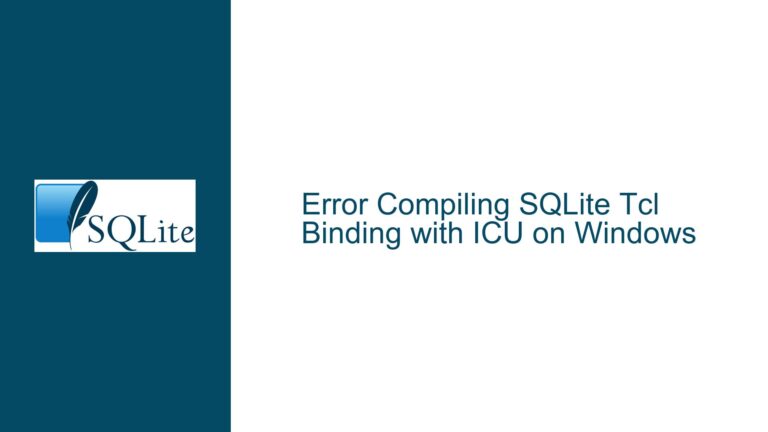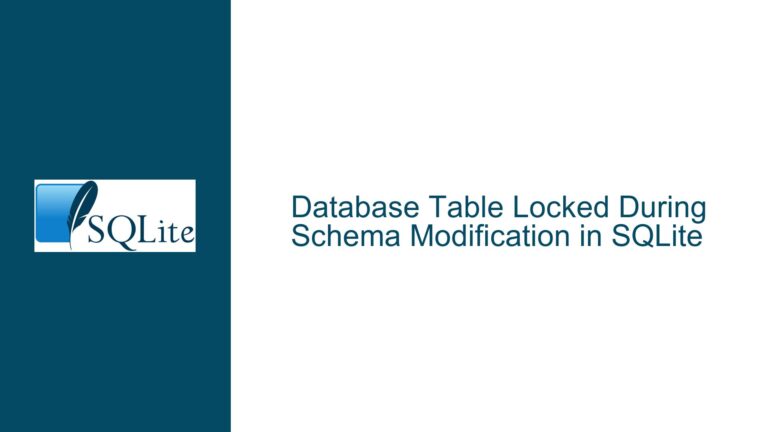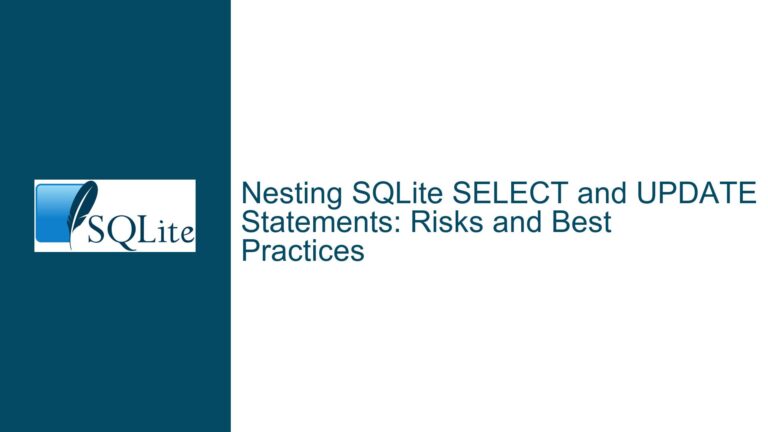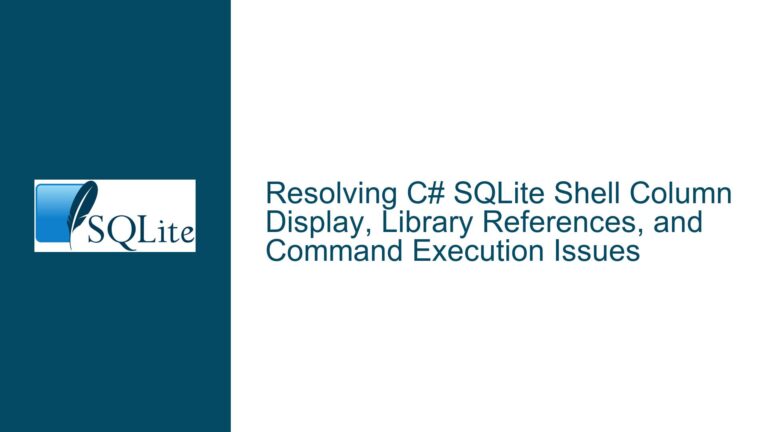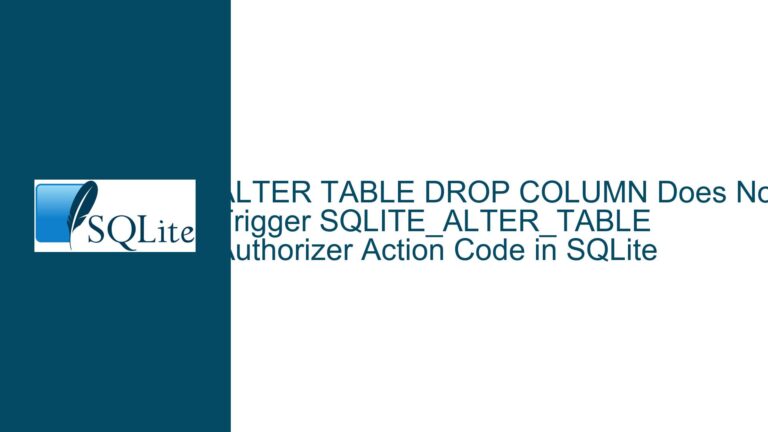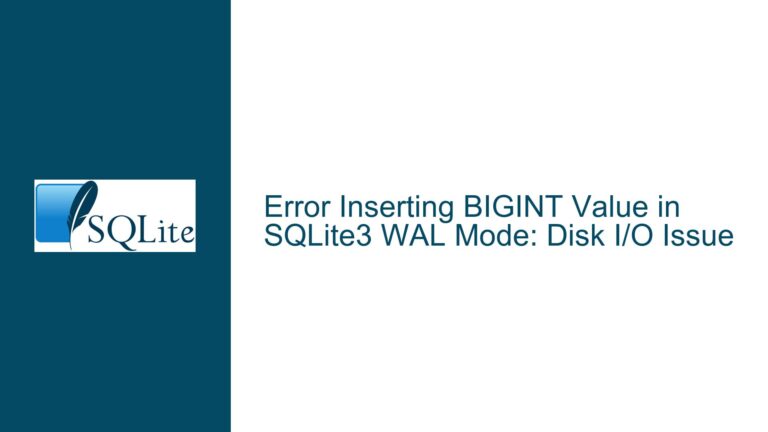SQLite-WASM: Handling Multiple Databases in Wrapped Worker Correctly
Issue Overview: Misrouted Database Commands in SQLite-WASM Worker
The core issue revolves around the behavior of the sqlite3Worker1Promiser in SQLite-WASM when handling multiple databases. Specifically, the problem manifests when a program attempts to interact with more than one database concurrently. The sqlite3Worker1Promiser is designed to facilitate asynchronous communication with SQLite databases in a WebAssembly (WASM) environment, particularly in web browsers where Web Workers are used to offload database operations from the main thread.
The crux of the issue lies in how the dbId (database identifier) is managed within the worker. When a database is opened using the open command, the worker returns a dbId that uniquely identifies that database instance. However, the worker incorrectly routes all subsequent database commands to the first-opened database, regardless of the dbId specified by the caller. This behavior effectively prevents the program from interacting with multiple databases simultaneously, as all commands are executed on the initial database, even if the caller explicitly specifies a different dbId.
This misrouting of commands can lead to data integrity issues, incorrect query results, and unexpected behavior in applications that rely on multiple databases. For instance, if an application uses one database for user data and another for logging, all logging operations might inadvertently be executed on the user database, leading to data corruption or loss.
The issue is particularly problematic in scenarios where multiple databases are essential for application functionality, such as in multi-tenant systems, where each tenant might have a separate database, or in applications that segregate data for security or organizational purposes. The inability to correctly route commands to the intended database undermines the utility of SQLite-WASM in such environments.
Possible Causes: Misaligned Database Identifier Management in Worker
The root cause of the issue can be traced to the internal management of the dbId within the sqlite3Worker1Promiser implementation. When a database is opened, the worker generates a dbId and stores it internally. However, the worker fails to correctly associate subsequent commands with the appropriate dbId, instead defaulting to the first dbId it encountered.
This misalignment likely stems from one or more of the following factors:
Incorrect State Management in Worker: The worker might not be maintaining a proper mapping between the
dbIdand the corresponding database instance. As a result, when a command is received, the worker defaults to the firstdbIdit stored, ignoring thedbIdspecified in the command.Improper Command Routing Logic: The logic responsible for routing commands to the correct database might be flawed. Specifically, the worker might not be parsing the
dbIdfrom the incoming command or might be overriding it with the firstdbIdit encountered.Lack of Thread-Safe Handling of Database Instances: In a multi-threaded environment like Web Workers, ensuring thread-safe access to shared resources is crucial. If the worker does not implement proper synchronization mechanisms, it might lead to race conditions where the
dbIdis incorrectly accessed or modified.Insufficient Validation of Caller-Specified
dbId: The worker might not be validating thedbIdprovided by the caller, leading to the use of an incorrect or staledbId. This could happen if the worker assumes that thedbIdis always valid or if it does not check whether thedbIdcorresponds to an open database.Defaulting to First
dbIdas a Fallback Mechanism: The worker might have a fallback mechanism that defaults to the firstdbIdin case of any errors or inconsistencies. While this might be intended as a safety measure, it inadvertently causes all commands to be routed to the first database.
Troubleshooting Steps, Solutions & Fixes: Correcting Database Command Routing in SQLite-WASM Worker
To address the issue of misrouted database commands in the SQLite-WASM worker, the following steps can be taken to diagnose, troubleshoot, and resolve the problem:
Review the
sqlite3Worker1PromiserImplementation: Begin by examining the source code of thesqlite3Worker1Promiserto understand how it managesdbIdand routes commands. Pay particular attention to the sections where thedbIdis stored, retrieved, and used to execute commands.Identify the Point of Failure: Determine the exact point in the code where the
dbIdis being mishandled. This could involve tracing the flow of a command from the caller to the worker and identifying where thedbIdis being overridden or ignored.Implement Proper
dbIdMapping: Ensure that the worker maintains a correct and up-to-date mapping betweendbIdand the corresponding database instance. This can be achieved by using a data structure like a map or dictionary to store thedbIdand its associated database.Enhance Command Routing Logic: Modify the command routing logic to correctly parse and use the
dbIdspecified by the caller. This involves updating the worker to extract thedbIdfrom the incoming command and use it to route the command to the appropriate database.Add Validation for Caller-Specified
dbId: Implement validation checks to ensure that thedbIdprovided by the caller corresponds to an open database. If thedbIdis invalid or does not match any open database, the worker should return an error rather than defaulting to the firstdbId.Ensure Thread-Safe Access to Database Instances: If the worker operates in a multi-threaded environment, implement synchronization mechanisms to prevent race conditions when accessing or modifying the
dbIdand database instances. This can be achieved using locks, mutexes, or other thread-safe constructs.Remove Default Fallback to First
dbId: Eliminate any fallback mechanisms that default to the firstdbIdin case of errors or inconsistencies. Instead, ensure that the worker handles errors gracefully and provides meaningful feedback to the caller.Test the Fixes: After implementing the changes, thoroughly test the worker to ensure that it correctly routes commands to the intended database. This involves creating test cases that simulate various scenarios, such as opening multiple databases, sending commands to different databases, and handling errors.
Submit the Fixes Upstream: Once the fixes have been validated, submit them to the upstream repository for integration. This ensures that the broader community can benefit from the improvements and that the issue is resolved in future releases.
Document the Changes: Update the documentation to reflect the changes made to the
sqlite3Worker1Promiserimplementation. This includes providing clear instructions on how to use the worker with multiple databases and detailing any new or modified APIs.
By following these steps, the issue of misrouted database commands in the SQLite-WASM worker can be effectively resolved, enabling applications to interact with multiple databases concurrently and correctly. This not only enhances the functionality of SQLite-WASM but also ensures data integrity and reliability in multi-database environments.

